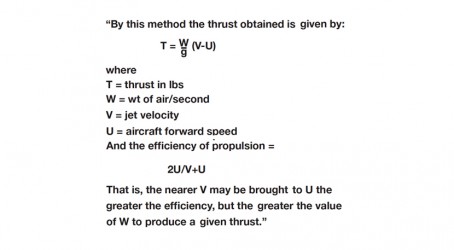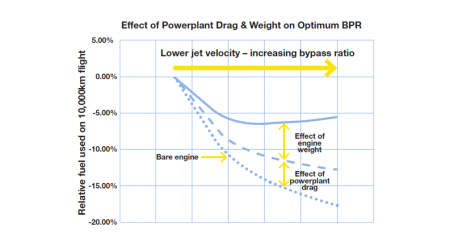Next May, it will be 60 years since the de Havilland Comet entered service as the world’s first jet passenger aircraft. The Comet launched an era that has enhanced the lives of almost everyone on the planet in the most positive way.
That it happened at all was due to a man in his early twenties, and a document that he penned 80 years ago. It shows the extent to which he was not only remarkably far-sighted, but intelligent in his perception of exactly what was required to make aircraft fly where they’d be most efficient – faster and higher.
Until recently that document had not seen the light of day for six decades. The paper I refer to is Frank Whittle’s original thesis, “Future Developments in Aircraft Design,” which he submitted in 1928 as part of his flight cadet course at Cranwell.
While researching an article covering the 70th anniversary of the first flight of Whittle’s jet engine, I discovered, through an old friend, Frank Armstrong, former head of the historical group at the Royal Aeronautical Society, that the thesis was still in existence in the archives at the Science Museum.
I obtained a copy of the paper to study in detail. In his thesis, Whittle foresaw that to be aerodynamically and structurally efficient at high speeds aircraft need to fly at high altitudes where air density is lower.
Passenger aircraft of the day were limited by the piston engine and propeller to speeds of about 100mph and altitudes of about 10,000ft, yet he wanted aircraft to fly at 400mph at 40,000ft and beyond. The power unit was the problem. Piston engines have high friction losses and lose power at altitude because of the reduction in air density.
To achieve his aim, Whittle proposed a gas turbine. In this, friction losses are negligible and power-to-weight ratio at altitude is high. He gave equations for the aerodynamic design of the turbine as well as the bursting stress of the disc.
However, while recognising that the gas turbine’s excellent power-to-weight ratio could give the power he needed at altitude, he observed that the size of the propeller to absorb such power would be large and heavy. So he drew the conclusion that for an aircraft to fly where it would be most efficient required a new prime mover, which would probably be a gas turbine. In other words, he had defined the aim but not the total solution.
In the year following his graduation from Cranwell, Whittle wrestled with the problem, eventually realising that exhausting the excess energy from the gas turbine as a jet of hot gas to provide propulsion, rather than to drive a propeller, would give an engine much lighter and more efficient at high speeds. Indeed, the faster it flew the more efficient it became.
His RAF commanding officer arranged for Whittle to present his novel ideas to the Air Ministry’s leading expert at the time, Dr A A Griffith, who had also proposed the use of a gas turbine at the same time as Whittle. However, Griffith’s gas turbine drove a propeller – an idea Whittle had rejected.
There was another difference: Griffith used an axial compressor rather than the centrifugal one Whittle proposed. Unfortunately, Griffith rejected Whittle’s idea as being too inefficient.
Whittle’s patent application of January 1930 included a drawing of a gas turbine jet engine with two stages of axial compression preceding a single-stage centrifugal compressor. It described how this arrangement would enable aircraft to fly high and fast. He also added a sentence: “In another form, a portion of the air only may expand through the expansion apparatus which drives the compression apparatus, and the remainder expands to the atmosphere providing fluid reaction.”
This implies that Whittle was already aware of the use of the bypass principle to improve propulsive efficiency.
Undeterred by Griffith’s rejection, Whittle wrote another paper outlining his proposal. He sent this to various aeroengine makers. In this ground-breaking engineering document, now owned by Rolls-Royce, Whittle not only showed the advantages of a gas turbine over a piston engine at altitude. He also demonstrated how a gas turbine using jet propulsion could fly at a speed of 341mph, with over four times the range at 40,000ft altitude than at sea level.
Several aspects demonstrate Whittle’s complete understanding of the thermodynamic principles and the challenges facing the designer.
First, his performance calculations were absolutely correct and, as Sir Stanley Hooker later described, were “laid down with the precision of Newton”. The methods are still used today.
Second, to further emphasise the benefits of altitude operation where ambient temperatures are low, Whittle devised a novel method of calculating and using the correct specific heats in his thermodynamic equations.
Finally, and most significantly, he provided the basic equations for the thrust and the propulsive efficiency of a jet engine:

This is one of the most important paragraphs in the history of aviation. Not only did Whittle give the basic equations for jet propulsion, but he identified the dilemma aeroengine designers would have, and still face today. Namely, achieving the correct balance between improving overall engine efficiency (lowering jet velocity by raising bypass ratio) against increasing airflow, which incurs drag and weight penalties. This is truly amazing – Whittle was only 23.
Aeroengine designers have struggled with this conflict since the advent of passenger jets 60 years ago. To combat the penalties of increasing airflow to improve efficiency, they first increased airflow per frontal area by adopting transonic blading to reduce power-plant drag and, more recently, through highly complex shapes seen in today’s engines.
They also designed novel ways to reduce the weight of fan blades. Rolls-Royce introduced the hollow titanium fan blade nearly 30 years ago, followed 10 years later by General Electric’s carbon-fibre blade. Now Pratt & Whitney has introduced the geared fan. All are aimed at solving the conflict Whittle identified more than 80 years ago.
Whittle also recognised that, to obtain maximum thermodynamic efficiency, turbine entry temperature must be as high as possible. Uniquely, he proposed silica turbine blades with inner and outer shrouds. He even gave the properties of silica and realised that it is brittle and poor in tension. So, he offered a design with silica in compression rather than tension. He also suggested three cooling methods.
History records that no one took up the ideas contained in Whittle’s remarkable engineering document for at least another five years. By this time his patent had lapsed. Had someone done so, the RAF could possibly have had jet fighters at the Battle of Britain.
But Whittle did not invent the jet engine as a means of waging war, though that is what funded its development and where it first saw service. His dream was of aircraft flying high and fast over long distances to far corners of the world. In 1952, when the first passenger jet entered service, a return journey across the Atlantic in an ocean liner cost three months’ average earnings and took five days. Today the same journey by air costs three days’ pay, takes seven hours and as a by-product puts fresh fruit and flowers in our homes all the year round.
The effect of this has been dramatic. In the developed countries people expect to fly away to sun-bathed beaches or visit relatives on the far side of the world at affordable cost. Even in poorer countries where flying is out of the question for most, a natural disaster such as an earthquake or tsunami brings almost instant medical assistance, food and aid. The global economy has benefited hugely as business people travel the world seeking new markets for their products and forging trading alliances.
In celebrating the 60th anniversary of the Comet’s entry into service, we acknowledge Whittle as the inventor of the jet engine. But he did much more – he founded the aviation industry as we know it and which has had an impact on the lives of almost everyone on the planet.

Lowering jet velocity to improve engine efficiency and reduce fuel consumption means that airflow has to increase to maintain thrust. This needs a fan size increase and hence larger power-plant whose drag and weight ultimately outweigh the benefit.
- Alec Collins FIMechE, FRAeS was formerly general manager, performance at Rolls-Royce.